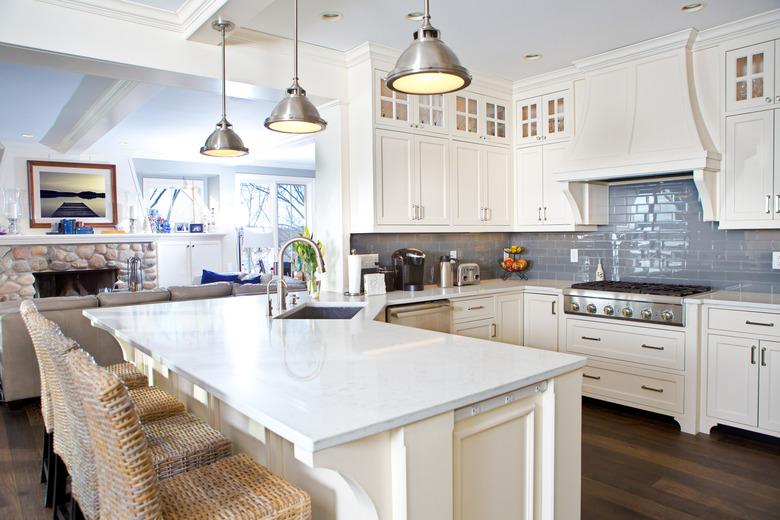How To Install A Light Fixture If There Is No Electrical Box
If you're wondering how you install a light fixture without an electrical box, the short answer is that you don't. The electrical box, or junction box, is a code requirement that was established to prevent fires and other electrical accidents. Whenever wires are spliced together in a circuit, whether it's to hook up a switch or light fixture or simply to extend the length of a wire, the splice connections must be inside a covered junction box.
You can't install a light fixture without a junction box, but the fact that there's no box at the spot where you want to install the light doesn't mean you can't install the light. Whenever it's too late to install a junction box in the wall without ripping off a large section of drywall, you can use a remodel junction box instead. It anchors to the back of the drywall and can support a fixture that weighs as much as 10 pounds.
Some Light Fixtures Have Junction Boxes
Some Light Fixtures Have Junction Boxes
Not all light fixtures require junction boxes because some have their own. These include recessed lighting cans, fluorescent fixtures and some types of track lighting. When installing one of these fixtures, it's okay to feed the wire straight into the terminal box, make connections and screw the box closed.
When feeding a cable into a fixture box, it's important to secure it with the clamp in the box. You should also secure the cable to studs with wire staples. If you have to poke a hole in the drywall to feed the cable through, there should be a staple as close to the hole as possible.
How to Use a Remodel Junction Box
How to Use a Remodel Junction Box
A remodel junction box is made of plastic and it isn't as deep as a conventional box, so it's intended for one, maybe two, connections only. Because it anchors to the drywall, you can install it anywhere on the wall or ceiling except in front of a stud.
The procedure for installing a remodel junction box calls for a pencil, drywall saw and screwdriver:
- Place the back of the box on the wall or ceiling and adjust it straight and level. Trace the outline of the back of the box on the drywall using a pencil.
- Cut along the trace line with a drywall saw and remove the cutout.
- Feed the electrical cables through the hole and the self-clamping holes on the back of the box. Fit the box into the hole until the front flange butts against the drywall.
- Turn one of the screws on the front of the box to rotate the plastic anchor in position against the back on the drywall. Pull the box out slightly while you tighten the screw to maintain the anchor in this position. Before you completely tighten the screw, repeat this procedure with the other screw, then tighten both screws fully to secure the box.
Once the box is in place, install the crossbar that comes with the light fixture, connect the wires and secure the fixture to the crossbar.
Install a Surface-Mount Box
Install a Surface-Mount Box
Remodel junction boxes aren't intended to use outdoors, so if you want to install a spotlight on the porch, screw a surface-mount box to the siding. Use a box rated for exterior use and be sure to seal it according to the manufacturer's recommendations.
If you're working indoors and have limited clearance for a surface-mount box, use a pancake box for a vanity light. This is similar to a conventional surface-mount box, with all the same knockouts and screw holes for securing it to a stud, but it's extremely shallow. If you need a junction box in the wall and have limited space, this is often a good option.
